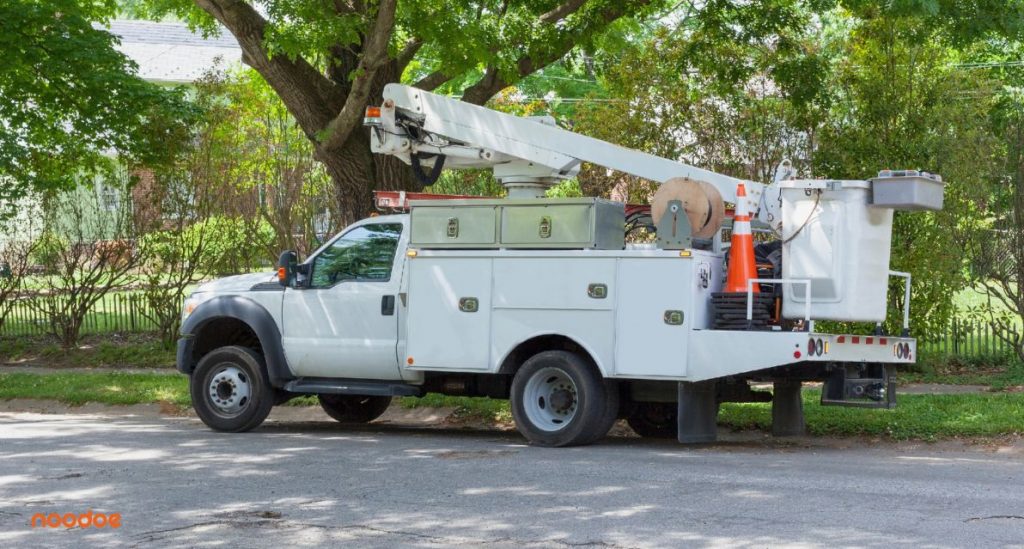Contact Info
2600 Technology Drive, Suite 100
Plano, Texas, 75074
United States
2600 Technology Drive, Suite 100
Plano, Texas, 75074
United States

Last Updated: March 29, 2024 | Fleet
It’s not news that the waves of change have been drawing the electric revolution inexorably closer. Transitioning to an electric commercial utility truck or van fleet, however, is a little different from trading in the family SUV. Electric vehicles are costly, and budgeting is a nightmare! Also, your average fleet vehicle has schedules and requires more consistent and often more expensive maintenance than home vehicles do. Electric vehicles also need new infrastructure: software-managed EV charging stations. Fleets suffer greatly if a charger or vehicle goes down. Thankfully, there are EV fleet management software and charging station solutions to these problems!
The first worry when electrifying any commercial fleet is how much the transition will cost. Utility fleet managers can’t just throw money at an idea because it’s green. Yes, EVs are more expensive up front. And that’s before thinking about the cost of installing on-site infrastructure. Those numbers add up! But if all you’re looking at is the sticker on day 1, you’re missing the full picture.
Electric utility trucks and vans cost more, but the story doesn’t end there. PG&E has an excellent breakdown of the total cost of ownership (TCO) of an EV fleet compared to a diesel one. Their analysis is for a 20-vehicle fleet, but the TCO benefits fleets of all sizes. Large and small electric fleets come with lower overall maintenance costs, lower fueling costs, and potential support from a range of local and federal grants and rebates. If you’re looking to trade in your trucks for EV work vans, you’re going to be pleasantly surprised in the long run.
Cities and states across the USA are encouraging fleets to transition their trucks and vans to electric. Grants and rebates exist at both state and federal levels to help cover the costs of vehicle and infrastructure transition. That means getting money to help you buy electric service trucks and charging solutions for your fleet! Which ones apply depends on your area. A fleet expert can help break down your needs (for vehicles, chargers, and EV fleet management software) and identify savings and subsidies available to you.
For most gas-powered fleets, maintenance is a huge line item in the annual budget. EVs simply have fewer parts to maintain. While they have the same basics found on gas-powered vehicles (brakes, windows, suspension), they lack the complications of internal combustion engines. That single change means sizeable savings down the road with electric fleet vehicles.
Electrified utility fleets need commercial vehicle charging solutions just like ICE vehicles need gas to function. While a lot has been written about the maintenance of electric trucks and vans, less exists on what it takes to maintain electric vehicle chargers. There’s a good reason for that; a well-built, quality AC or DC charging station requires almost no maintenance! But what about downtime? It seems like every day bring another story about down chargers. Thankfully, Noodoe chargers operate use Noodoe EV OS as their EV fleet charging management software. The system is highly automated, meaning it runs diagnostics and recovery on its own, keeping the system up and running, dramatically reducing downtime worries. The system simplifies management for large and small fleet charging, so keeping your vehicles ready and on schedule is as hands-off and reliable as possible. Noodoe EV OS has an average 99.9% software uptime. No need to worry about reliability issues there.
There are a lot of reasons to transition to an electrified utility fleet. Whatever the reason, it’s important to have the right partner. That means talking to someone who has been there, knows all the potential pitfalls, and can help guide you through the process. If you’re looking for this kind of expert, you’re in the right place. Noodoe knows fleets! Reach out and let us get you started!
| Cookie | Duration | Description |
|---|---|---|
| cookielawinfo-checkbox-analytics | 11 months | This cookie is set by GDPR Cookie Consent plugin. The cookie is used to store the user consent for the cookies in the category "Analytics". |
| cookielawinfo-checkbox-functional | 11 months | The cookie is set by GDPR cookie consent to record the user consent for the cookies in the category "Functional". |
| cookielawinfo-checkbox-necessary | 11 months | This cookie is set by GDPR Cookie Consent plugin. The cookies is used to store the user consent for the cookies in the category "Necessary". |
| cookielawinfo-checkbox-others | 11 months | This cookie is set by GDPR Cookie Consent plugin. The cookie is used to store the user consent for the cookies in the category "Other. |
| cookielawinfo-checkbox-performance | 11 months | This cookie is set by GDPR Cookie Consent plugin. The cookie is used to store the user consent for the cookies in the category "Performance". |
| viewed_cookie_policy | 11 months | The cookie is set by the GDPR Cookie Consent plugin and is used to store whether or not user has consented to the use of cookies. It does not store any personal data. |
